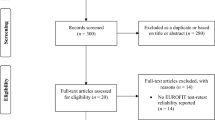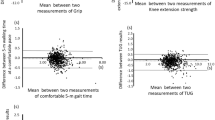Abstract
Current methods of assessing coordination in Paralympic classification are non-instrumented and are based on ordinal scales of measurement and therefore impede the development of evidence-based methods of classification. This paper describes an instrumented battery of tests that measure impaired coordination in a way that will permit evidence-based classification. Test–retest reliability and normative values for each of the tests are reported. Twenty participants visited the laboratory on two occasions, each time completing 11 tests: three running-specific, lower-limb reciprocal tapping tests (yielding five outcome measures); four throwing-specific, upper-limb discrete tapping tests (yielding four outcome measures); and four wheelchair-specific, upper-limb reciprocal tapping tests yielding seven outcome measures. Reliability was evaluated using Intra-class Correlation Coefficients (ICCs), Standard Error of Measurement, Limits of Agreement and Paired t-tests. ICCs for fourteen of the 16 outcome measures were excellent (ICC ≥ 0.80), although systematic bias was evident in two of these—a unilateral, running-specific lower-limb tests on the non-dominant side, and a unilateral wheelchair-specific upper limb test on the dominant side. ICCs for two tests—a bilateral wheelchair-specific upper limb test (0.74), and a unilateral wheelchair-specific upper limb test on the non-dominant side (0.54)—were good and fair respectively. Results indicate that 12 of the measures evaluated have measurement properties that will facilitate the development of evidence-based methods of Paralympic classification in athletics. Positional adjustment and increased familiarization may improve reliability in the other four. Studies evaluating reliability of this test battery in people with coordination impairments are warranted.



Similar content being viewed by others
References
Connick MJ, Beckman E, Ibusuki T, Malone L, Tweedy SM Evaluation of methods for calculating maximal allowable standing height in amputees competing in Paralympic athletics. Scand J Med Sci Sports (in Press)
Tweedy SM, Vanlandewijck YC (2011) International Paralympic Committee position stand--background and scientific principles of classification in Paralympic sport. Br J sports Med 45(4):259–269. doi:10.1136/bjsm.2009.065060
Beckman EM, Newcombe P, Vanlandewijck Y, Connick MJ, Tweedy SM (2014) Novel strength test battery to permit evidence-based paralympic classification. Med 93(4):e31. doi:10.1097/MD.0000000000000031
International Paralympic Committee (2012) Annual report. IPC, Bonn
International Paralympic Committee (2014) IPC athletics classification rules and regulations. IPC, Bonn
O’Sullivan SB, Schmitz TJ, Fulk G (2013) Physical rehabilitation, 6th edn. F. A. Davis Company, Pennsylvania
Tweedy S, Beckman EM, Connick MJ (2014) Paralympic Classification - Conceptual basis, current methods and research update. PM R 6(8 Suppl):S11–S17
Feys PG, Davies-Smith A, Jones R, Romberg A, Ruutiainen J, Helsen WF, Ketelaer P (2003) Intention tremor rated according to different finger-to-nose test protocols: a survey. Arch Phys Med Rehabil 84(1):79–82. doi:10.1053/apmr.2003.50068
Woodworth RS (1899) The accuracy of voluntary movement. Psychol Rev 3:1–114
Elliott D, Hansen S, Grierson LE, Lyons J, Bennett SJ, Hayes SJ (2010) Goal-directed aiming: two components but multiple processes. Psychol Bull 136(6):1023–1044. doi:10.1037/a0020958
Fitts PM, Peterson JR (1964) Information capacity of discrete motor responses. J Exp Psychol 67:103–112
Fitts PM (1954) The information capacity of the human motor system in controlling the amplitude of movement. J Exp Psychol 47(6):381–391
Atkinson G, Nevill AM (1998) Statistical methods for assessing measurement error (reliability) in variables relevant to sports medicine. Sports Med 26(4):217–238
Connick MJ, Beckman E, Spathis J, Deuble R, Tweedy SM (2015) How Much Do Range of Movement and Coordination Affect Paralympic Sprint Performance? Med sci sports Exerc. doi:10.1249/MSS.0000000000000643
Cohen J (1988) Statistical power analysis for the behavioral sciences, 2nd edn. Psychology Press, Erlbaum
Connick MJ, Beckman EM, Tweedy SM (2015) Relative Age Affects Marathon Performance in Male and Female Athletes. J Sports sci Med 14(3):669-674
Shrout PE, Fleiss JL (1979) Intraclass correlations: uses in assessing rater reliability. Psychol Bull 86(2):420–428
Blacker D, Endicott J (2000) Psychometric properties: concepts of reliability and validity. In: Rush AJ (ed) Handbook of psychiatric measures. American Psychiatric Publishing, Arlington, pp 7–14
Spathis JG, Connick MJ, Beckman EM, Newcombe PA, Tweedy SM (2015) Reliability and validity of a talent identification test battery for seated and standing Paralympic throws. J Sports Sci 33(8):863-871. doi:10.1080/02640414.2014.969294
International Paralympic Committee (2007) International Paralympic Committee (IPC) classification code and international standards. IPC, Bonn
Deuble RL, Connick MJ, Beckman EM, Abernethy B, Tweedy SM (2015) Using Fitts' Law to Detect Intentional Misrepresentation. J Motor Behavior 1–8. doi:10.1080/00222895.2015.1058744
Acknowledgments
This research was supported by the Australian Research Council (Grant LP0882187), the International Paralympic Committee (IPC) and the Australian Sports Commission. The authors thank Mr. Calum MacFadyen and Ms. Shinead Rooney for their hard work in collection of these data.
Author information
Authors and Affiliations
Corresponding author
Ethics declarations
Conflict of interest
The authors declare that they have no conflict of interest.
Rights and permissions
About this article
Cite this article
Connick, M.J., Beckman, E., Deuble, R. et al. Developing tests of impaired coordination for Paralympic classification: normative values and test–retest reliability. Sports Eng 19, 147–154 (2016). https://doi.org/10.1007/s12283-016-0199-5
Published:
Issue Date:
DOI: https://doi.org/10.1007/s12283-016-0199-5




